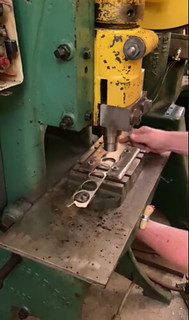
PREV ARTICLE
NEXT ARTICLE
FULL ISSUE
PREV FULL ISSUE
WEBBING DEFINITIONS ON THE NEWMAN PORTALNewman Numismatic Portal Project Coordinator Len Augsburger provided this follow-up to our earlier discussion of 1943 steel cent webbing. -Editor More on Webbing, or, “The Specifics of Scissel” -- “Webbing” is one of a few useful words to describe the leftover scrap from the planchet cutting process. The Dick Johnson Encyclopedia gives more precise definitions, ranging from the most general to the most specific: Shruff is described as all the metal rubbish from the minting process, including clippings, blanks, mis-struck pieces, etc., of which scissel would be a subset. Scissel is the metal scrap from blanking and trimming and for the most part consists of skeleton scrap, but also includes circular rings remaining after cutting down oversize planchets. Skeleton Scrap is the webbing that most of us think of, as it is the most visually striking of the remnants. For some odd reason, all these words start with S.  With respect to skeleton scrap, Phil Mossman has used the word “fillet,” which Wikipedia defines as “a rounding of an interior or exterior corner of a part design,” while an 18th U.S. Mint document used the word “clippings” (see Money of the American Colonies, p. 223). The British Mint was apparently more sophisticated on these matters, and used the word “scissel” in a 1773 document related to the coinage for colonial Virginia (cited in Eric Newman’s Coinage for Colonial Virginia, 1956, p. 54). Another word found is “honeycomb,” which was used by Robert Kriz in correspondence with Eric Newman (9/25/1978) discussing U.S. manufacture of Philippine coins. The last is apparently a unique usage and probably particular to this specific writer. Finally, Frey’s dictionary (published in the American Journal of Numismatics, first series, vol. 50, 1916) notes alternate spellings of “sizel” and “sisel,” and reports that “syssel” was used in an English Mint document, c. 1572. Link to the NNP Dictionary, including Frey’s dictionary and the Johnson Encyclopedia of Coin and Medal Technology:
Link to Phil Mossman’s Money of the American Colonies on NNP:
Link to Eric Newman’s Coinage for Colonial Virginia on NNP:
Link to Newman/Kriz correspondence on NNP:
This video, which conveniently pairs with the subject, was just posted on the Ron Landis Facebook page. Ron posted a series of videos on the coin-making process. This one shows blank planchets being cut from a strip of metal, leaving behind skeleton scrap. -Editor To watch the video, see:
To read the earlier E-Sylum articles, see:
Wayne Homren, Editor The Numismatic Bibliomania Society is a non-profit organization promoting numismatic literature. See our web site at coinbooks.org. To submit items for publication in The E-Sylum, write to the Editor at this address: whomren@gmail.com To subscribe go to: https://my.binhost.com/lists/listinfo/esylum All Rights Reserved. NBS Home Page Contact the NBS webmaster 
|
